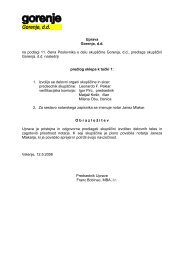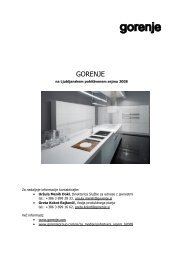ANNUAL REPORT 2008 - Gorenje Group
ANNUAL REPORT 2008 - Gorenje Group
ANNUAL REPORT 2008 - Gorenje Group
Create successful ePaper yourself
Turn your PDF publications into a flip-book with our unique Google optimized e-Paper software.
91<br />
ble for use, the recoverable amount is estimated annually prior to the preparation for the financial<br />
statements.<br />
The recoverable amount of an asset or cash-generating unit is the greater of its value in use and its<br />
fair value less costs to sell. In assessing value in use, the estimated future cash flows are discounted<br />
to their present value using a pre-tax discount rate that reflects current market assessments of the<br />
time value of money and the risks specific to the asset. For the purpose of impairment testing, assets<br />
are grouped together into the smallest group of assets that generates cash inflows from continuing<br />
use that are largely independent of the cash inflows of other assets or groups of assets (the<br />
“cash-generating unit”). The goodwill acquired in a business combination, for the purpose of impairment<br />
testing, is allocated to cash-generating units that are expected to benefit from the synergies<br />
of the combination.<br />
An impairment loss is recognised if the carrying amount of an asset or its cash-generating unit exceeds<br />
its estimated recoverable amount. Impairment losses are recognised in profit or loss. Impairment<br />
losses recognised in respect of cash-generating units are allocated first to reduce the carrying<br />
amount of any goodwill allocated to the units and then to reduce the carrying amount of the<br />
other assets in the unit (group of units) on a pro rata basis.<br />
An impairment loss in respect of goodwill is not reversed. In respect of other assets, impairment<br />
losses recognised in prior periods are assessed at each reporting date for any indications that the<br />
loss has decreased or no longer exists. An impairment loss is reversed if there has been a change<br />
in the estimates used to determine the recoverable amount. An impairment loss is reversed only to<br />
the extent that the asset’s carrying amount does not exceed the carrying amount that would have<br />
been determined, net of depreciation or amortisation, if no impairment loss had been recognised.<br />
( j ) N o n - c u r r e n t a s s e t s h e l d f o r s a l e<br />
Non-current assets (or disposal groups comprising assets and liabilities) that are expected to be<br />
recovered primarily through sale rather than through continuing use are classified as held for sale.<br />
Immediately before classification as held for sale, the assets (or components of a disposal group)<br />
are re-measured in accordance with the <strong>Group</strong>’s accounting policies. Thereafter generally the assets<br />
(or disposal group) are measured at the lower of their carrying amount and fair value less cost<br />
to sell. Any impairment loss on a disposal group first is allocated to goodwill, and then to remaining<br />
assets and liabilities on pro rata basis, except that no loss is allocated to inventories, financial assets,<br />
deferred tax assets, employee benefit assets, investment property and biological assets, which<br />
continue to be measured in accordance with the <strong>Group</strong>’s accounting policies. Impairment losses on<br />
initial classification as held for sale and subsequent gains or losses on re-measurement are recognised<br />
in profit or loss. Gains are not recognised in excess of any cumulative impairment loss.<br />
(k) Employee benefits<br />
(i) Short-term benefits<br />
Short-term employee benefit obligations are measured on an undiscounted basis and are expensed<br />
as the related service is provided.<br />
(l) Provisions<br />
A provision is recognised if, as a result of a past event, the <strong>Group</strong> has a present legal or constructive<br />
obligation that can be estimated reliably, and it is probable that an outflow of economic benefits<br />
will be required to settle the obligation. Provisions are determined by discounting the expected<br />
future cash flows at a pre-tax rate that reflects current market assessments of the time value of<br />
money and the risks specific to the liability.

















